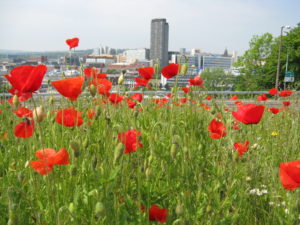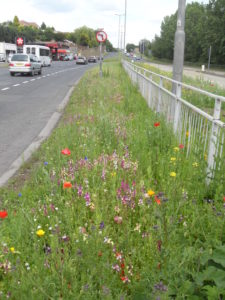You can booost biodiversity by letting local verges and green spaces grow wilder, at any scale. Here are some top tips.
Gardens
Please visit our Wildlife Gardening Page.
Grounds of a premises, school or business
If the grounds are relatively small, you could start by taking a look at the Wildlife Gardening Page. Don’t forget to get permission from the landowner before making any changes.
If the grounds are large, you may want to consider buying in professional services from our consultancy Wildscapes. They can provide you with ecological advice, a management plan and make changes on the ground.
Local green space
Do you know who owns the green space? It may be Sheffield City Council or Rotherham Borough Council. Find contact details below:
Sheffield City Council: Parksandcountryside@sheffield.gov.uk or 0114 2500500
Rotherham Borough Council: Green Spaces Department
There may also be an existing Local or Friends of Group in Sheffield or Rotherham associated with the Green space.

Things to consider before creating a meadow or sowing wildflowers
Did you know? Sheffield and Rotherham have lost most of their species-rich grasslands – for example, Sheffield has lost over 75% of its local biodiverse grasslands since 1980’s. You can help reverse this trend by letting grasslands grow wild again.
🌼You can let existing grassland grow with reduced or no mowing – you may be surprised to see how many different kinds of flowers are already there if they’re allowed to grow.
🌼You can create a traditional meadow, or sow a wildflower mix instead. A meadow is “a mix of perennial wild grasses and wild flower seed”, while plant pots and flower bed are perfect for a wildflower seed mix.
🌼Find out what kind of soil you have, for best results.
🌼Consider how the wildflowers or meadow will be managed over time
🌼What other habitats and wildlife features can you create alongside your meadow or wildflower beds?
Top tip: Aim for “structural diversity” – different heights of vegetation. This provides microclimates for invertebrates as well as a diversity of plant species. Don’t forget scrub and hedgerows, which also support birds and small mammals.
Top tip: Choose native, perennial seeds from a reputable supplier. Native perennial flowers and grasses will not have such a long colourful flowering season compared with a mixture of non-native species (e.g. Pictorial Meadow which are sometimes chosen for city-centre projects for example), but still look fabulous in early summer. Annuals give a more immediate flash of colour but will need to be re-seeded every year.
Top tip: Both native and non-native species support invertebrates, including pollinators. However, native plants and invertebrates have evolved side by side, and native plants support these invertebrates at all stages of their life cycle. Suggested local native plant species can be found here.
Trees and ponds
🌳 Is this the right place for trees, or is it already a good quality habitat? If you’re not sure, please seek advice from us. There are a number of tree planting initiatives potentially available through Sheffield and Rotherham Wildlife Trust and partner organisations. Please contact us for more information as initiatives change quickly.
There are currently several sources of free and subsidised trees available via the following links:
https://www.tcv.org.uk/news/3-
https://www.woodlandtrust.org.
https://www.woodlandtrust.org.
🐸 Have you thought about a pond? Check out information on ponds and other small features that can be introduced on the wildlife gardening page.
Suppliers
If you are buying wildflower seed, be careful where you are sourcing it from – particularly if you are wanting just native wildflowers, as the provenance is not always clear. We recommend Emorsgate or Naturescape. For more suppliers of useful enhancements to your greenspace see SRWT Good practice enhancements for biodiversity in developments.
Follow this link to learn how to create your meadow or wild patch.
Road verges
Road verges can be remnants of original habitat or created as new habitats in the urban environment. They are linear habitats which can connect other larger areas of habitat as part of ecological networks. The way they are managed can have a big impact on the diversity of plants, invertebrates and other wildlife that they can support.
Most road verges are the responsibility of the Local Authority – except for major trunk roads which are managed by Highways England. Due to health and safety considerations and the location of underground infrastructure, permission must be sought to plant anything in the road verge.
Rotherham road verges
See here for how to apply for permission to plant in a road verge in Rotherham.
You will also find information about Rotherham Council’s grass cutting schedule and the pictorial meadows planting on the A630 on this page.

Sheffield road verges
In Sheffield, most road verges are managed by Amey on behalf of Sheffield City Council as part of the Streets Ahead contract.
Sheffield City Council are still looking to introduce a process to permit wildflower planting and maintenance by residents, as yet the process has not been finalised. In the meantime, any requests should be made to highways@sheffield.gov.uk.
From 2015-2019 Sheffield and Rotherham Wildlife Trust collaborated with Streets Ahead and the University of Sheffield on the Sheffield Living Highways Project. You can find out about achievements and lessons learnt here.
Want to know more about managing road verges for wildlife?
Please visit here where you can find advice and case studies from across the Wildlife Trust movement and download the Best Practice Guide to Managing Road Verges.
You can also read the proceedings from the Road Verge Symposium 2019 organised by Sheffield and Rotherham Wildlife Trust Butterfly Conservation and Natural England, here.
Any questions?
Contact us via takeaction@wildsheffield.com or 0114 2634335